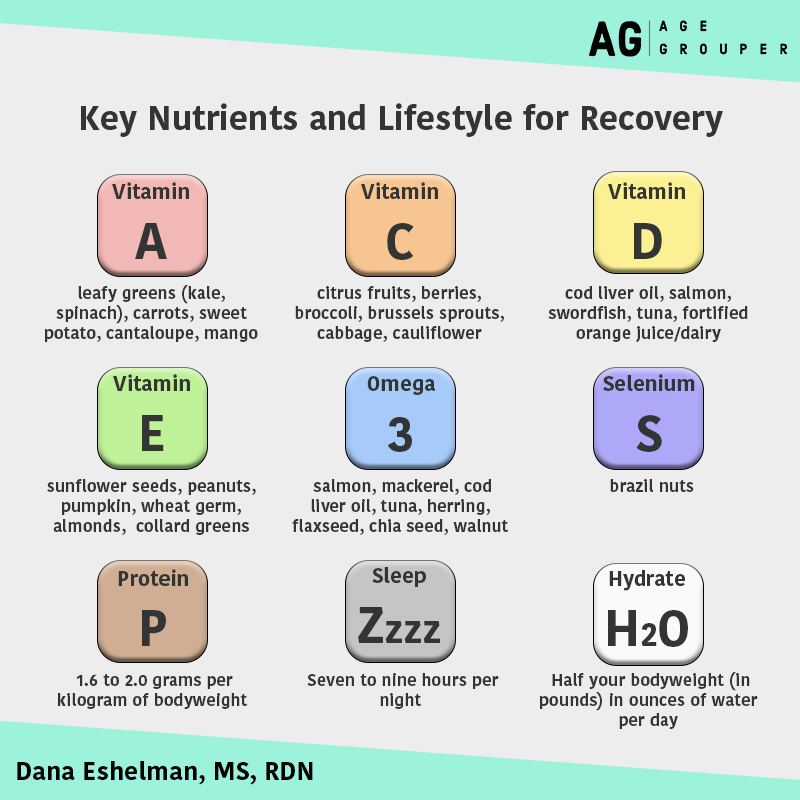Eating for Recovery, It’s More Complex than you Think
Clinical dietitian and endurance sports nutritionist Dana Eshelman breaks down exactly what your body needs in your recovery meals.

Nutrition and training go hand in hand. The proper fueling plan not only supports the body during a workout, but aids in its recovery afterwards. Did you know that skipping a meal or post training snack stalls recovery, downregulates metabolism and enhances the body’s fat storage? The hard work put in during workouts, must be supported through recovery.
During exercise, your body uses glycogen (the storage form of carbohydrates) from your muscles and liver as fuel. Your body can store anywhere from 1,400 to 2,000 calories of glycogen, which is enough for about 90 minutes of endurance exercise. Therefore, athletes should fuel with carbohydrates during workouts lasting longer than 90 minutes for optimal performance.
Ok, so now the workout is over. Now what?
Our Post Workout Physiology
Regardless of the duration or intensity of a workout, athletes should replenish their bodies following exertion of any kind. There are many processes occurring simultaneously within the body, so let’s break down what is happening and why fueling for recovery is so important.
Energy stores are empty. The muscles are fatigued and have been depleted of its energy stores. The body immediately turns to its food sources to replenish what was lost. A mix of 2 to 3 grams of carbohydrates to 1 gram of protein is best here.
Insulin levels are peaking. Insulin is a hormone responsible for regulating carbohydrate and fat metabolism. As insulin is released, glucose is absorbed into the bloodstream and skeletal muscle tissues in the storage form of glycogen, or fat stored in adipose tissue, and transformed into energy. This process transports nutrients throughout the body.
When exercise starts, insulin is suppressed to allow the glucose to be used as fuel during the training session. At this point, it is best to limit those sugar-ridden sports beverages for workouts lasting less than 60 minutes, especially if your goal is to improve body composition. Immediately following a workout, insulin levels begin to peak again, meaning nutrients from food will move quickly and efficiently to your muscles. This is where the refueling window of 30 to 45 minutes comes from to replenish glycogen stores and promote muscle protein synthesis (aka muscle growth).
Hormones begin to rebalance. During training, cortisol naturally increases in our body to support an increase in energy metabolism. Cortisol regulates blood sugar by aiding in fat and protein metabolism to create glucose to fuel training sessions. Note, entering a training session not yet fully recovered from a previous workout, and/or engaging in a session lasting longer than 90 minutes, can increase the risk of breaking down muscle for fuel. You can avoid this by fueling throughout training sessions and supplying your body with 30 to 90 grams of carbs per hour (with sessions lasting longer than 90 minutes).
As glycogen stores are replenished by carbohydrates in the form of glucose, the body will more quickly regulate its hormonal imbalances.
Muscles begin to rebuild. Protein synthesis (aka muscle gains) begin as soon as the body has a readily available source of protein in the form of amino acids. The body needs all nine essential amino acids in order to begin rebuilding and restoring muscle tissue: histidine, isoleucine, leucine, lysine, methionine, phenylalanine, threonine, tryptophan and valine. While each is integral in restoring and building muscle tissue, the most important amino acid is leucine because it kickstarts the process.
One should try to consume protein at all meals and snacks throughout the day. Aim for 20 to 40 grams of protein post training sessions to adequately supply your muscles with the fuel they need for repairing and building. The more quickly the body is supplied with these essential amino acids, the faster it can rebuild and restore muscle tissue.

Timing is Everything for Recovery Meals
There is a “window of opportunity”—approximately 30 to 45 minutes post training session—to replenish your muscles with amino acids and glucose. After this time, the insulin levels begin to drop thus slowing down the delivery process.
This time frame is particularly important for women. Unlike men whose insulin levels decline more gradually, women see a significant drop in insulin within the first 30 minutes post workout. A missed recovery meal/snack can reduce total glycogen storage. Waiting two to two and a half hours to refuel decreases your glycogen storage rate by 50 percent.
For women in the peri- and menopause years, insulin resistance occurs as a result of lower estrogen, so its particularly advantageous to consume at least 25 to 30 grams of protein with 30 to 60 grams of carbohydrate within 30 minutes post hard training session for optimal recovery and body composition.
Protein is Critical for Recovery
For both women and men, protein is essential. Twenty five to 30 grams of protein in a recovery meal will supply the body with the fuel it needs to rebuild muscle.
For women, consuming protein post workout becomes increasingly important. One reason for this is to counter the effects of progesterone, a hormone released during the later stages of a woman’s menstrual cycle. This hormone is catabolic in nature, meaning it signals the body to start breaking down muscle for fuel. Should this happen, recovery is stunted and you will see a reduction in muscle mass. When progesterone levels are at their peak, protein consumption post workout is critical.
Decreasing Inflammation and Improving Immunity
Training sessions induce an inflammatory cascade that increases blood flow to the working muscles in order to replenish oxygen, fuel the muscle with nutrients and clear out the waste or by-products the muscle is not using. During this cascade of elevated high sensitivity C-reactive protein (hs-CRP), creatine kinase (CK) and cortisol, the immune system is heightened and white blood cells (WBC) increase to clean up the cellular debris and waste. At this point, the body can begin to repair and restore any damaged tissue. Keep in mind, when we train we are breaking down muscle tissue so it can be built up stronger. This is where nutrition comes into play.

Nutrients to Avoid During Recovery Meals
Added sugars – limit these in your day to day diet; check labels under “total added sugars.” Men should have no more than 36 grams added sugar per day and females no more than 25 grams added sugar per day. Keep in mind however, that added sugars during training sessions and races are important for performance.
High saturated fat – Saturated fat is the fat that can increase cardiovascular disease risk and exacerbate inflammation. These fats are found in butter, palm and coconut oils, cheese, and red meat. Instead stick to unsaturated fats such as olive oil, avocado and walnuts.
. . .
Dana Eshelman MS, RDN is a performance dietitian that helps endurance athletes find hormone balance and optimize gut health through flexible nutrition so they can level up their performance. Dana is a multisport athlete and runner herself, and understands the demands of endurance training and competing. She strives to simplify nutrition for athletes, improve understanding of how to fuel and hydrate for training and competition, and enhance daily lifestyle habits for life-long success.
IG: @adashofdanardn

